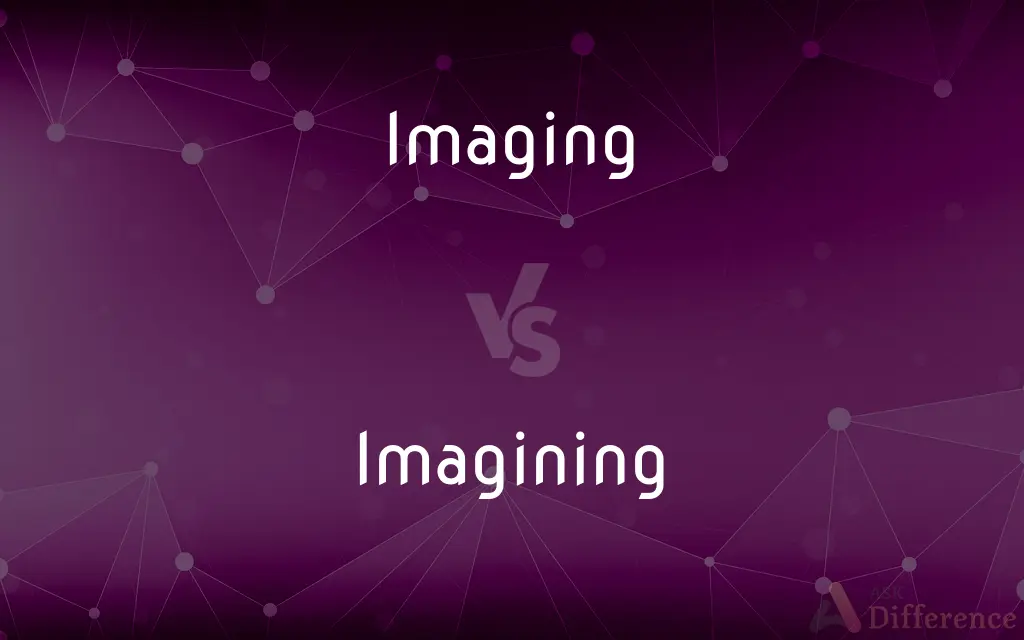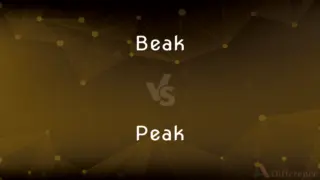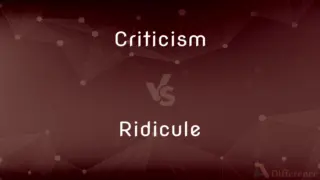Imaging vs. Imagining — What's the Difference?
Edited by Tayyaba Rehman — By Maham Liaqat — Updated on April 1, 2024
Imaging involves capturing or creating visual representations, while imagining is the mental process of creating or thinking of something not present.

Difference Between Imaging and Imagining
Table of Contents
ADVERTISEMENT
Key Differences
Imaging is a technique used to capture or create visual representations of objects, areas, or phenomena using various technologies such as photography, MRI, and X-rays. This process is essential in fields like medicine, astronomy, and photography, where visual documentation or analysis is crucial. On the other hand, imagining refers to the mental process of creating images, scenarios, or concepts in the mind that are not immediately present to the senses. It is a cognitive ability that plays a significant role in creativity, problem-solving, and planning.
While imaging requires specific tools, techniques, and sometimes physical materials to create or capture visual representations, imagining relies solely on the individual's cognitive faculties without the need for external devices. Imagining enables individuals to conceptualize new ideas, anticipate outcomes, and engage in creative thought, whereas imaging often aims to document, analyze, or aid in the understanding of visible phenomena.
Imaging technologies and techniques have evolved significantly over time, from simple photographic methods to advanced techniques like 3D imaging and thermal imaging, expanding their application across various fields. Conversely, the process of imagining, while inherently human and subjective, has been studied extensively in psychology and neuroscience to understand its impact on behavior, creativity, and mental health.
The purpose and outcomes of imaging and imagining also differ markedly. Imaging is frequently used for diagnostic, analytical, or artistic purposes, providing tangible outputs that can be shared, studied, or appreciated visually. Imagining, however, often serves as a precursor to innovation or the creative process, influencing personal decisions, artistic creation, and problem-solving strategies without necessarily producing immediate physical outcomes.
Both imaging and imagining are valuable in educational and professional contexts, but they serve different roles. Imaging helps in the concrete visualization of concepts, aiding in learning and communication, especially in sciences and arts. Imagining, however, fosters critical thinking, creativity, and the ability to envision possibilities beyond the current reality, which are crucial skills in virtually all disciplines.
ADVERTISEMENT
Comparison Chart
Definition
The process of creating or capturing visual representations using various technologies.
The mental process of creating images or concepts not present to the senses.
Tools Required
Yes, such as cameras, scanners, MRI machines.
No, relies solely on cognitive abilities.
Purpose
To document, analyze, or visualize physical phenomena.
To conceive new ideas, solve problems, or engage in creative thought.
Tangibility
Produces tangible outputs (photos, scans, etc.)
Results are intangible, existing in the mind's eye.
Fields of Application
Medicine, astronomy, photography, etc.
All fields requiring creativity, planning, or problem-solving.
Compare with Definitions
Imaging
Aims to provide an accurate, objective representation of the subject.
Satellite imaging offers precise data on weather patterns and climate change.
Imagining
Personal and subjective, influenced by the individual's thoughts and emotions.
Literature often explores the power of imagining as a window into human desires and fears.
Imaging
Relies on technological devices to capture or create images.
Advanced imaging technologies have revolutionized the study of ancient artifacts.
Imagining
The act of forming new ideas or images in the mind that are not perceived through the senses.
Imagining alternative outcomes is a common psychological coping mechanism.
Imaging
The process of creating visual representations of objects or phenomena using technical equipment.
Imaging techniques like X-rays and MRI scans are crucial in medical diagnostics.
Imagining
Integral to creativity, problem-solving, and planning across all human activities.
Scientists use imagining to theorize about phenomena not yet observed.
Imaging
Results in physical or digital images that can be analyzed and shared.
Digital imaging has made it easier to share and store photographs electronically.
Imagining
Produces no physical output, existing only in the mind's eye.
Imagining scenarios is a key step in the creative writing process.
Imaging
Used across multiple disciplines for analysis, documentation, and art.
In forensic science, imaging techniques are essential for evidence analysis.
Imagining
A fundamental cognitive process not reliant on external tools.
Creative professionals excel at imagining innovative solutions to complex problems.
Imaging
Visual representation of an object, such as a body part or celestial body, for the purpose of medical diagnosis or data collection, using any of a variety of techniques, such as ultrasonography or spectroscopy.
Imagining
To form a mental picture or image of
Imagined a better life abroad.
Imaging
Present participle of image
Imagining
To think or suppose; conjecture
I imagine you're right.
Imaging
The technique or practice of creating images of otherwise invisible aspects of an object, especially of body parts.
Imagining
To have a notion of or about without adequate foundation; fancy or believe
She imagines herself to be a true artist.
Imaging
The use of mental images to alter a person's perceptions or behaviors.
Imagining
To employ the imagination.
Imaging
The ability to form mental images of things or events;
He could still hear her in his imagination
Imagining
To have a belief or make a guess.
Imaging
(medicine) obtaining pictures of the interior of the body
Imagining
Something imagined; a figment of the imagination.
Imagining
Present participle of imagine
Imagining
Present participle of imagin
Common Curiosities
How do imaging and imagining differ in terms of tools required?
Imaging requires technological devices, whereas imagining relies solely on cognitive abilities.
Do imaging and imagining produce tangible results?
Imaging produces tangible outputs like photographs and scans, while imagining results are intangible.
How does imagining influence creativity?
Imagining is fundamental to the creative process, enabling the formation of novel ideas and visions.
Can imaging and imagining be used together?
Yes, imaging can bring imagined concepts to life, and imagining can inspire the use of imaging in creative ways.
What are some examples of imaging technologies?
Examples include photography, MRI scans, and thermal imaging.
Is special training required for imaging?
Yes, operating imaging equipment and interpreting results often require specialized training.
Can imagining have therapeutic uses?
Yes, techniques like guided imagery are used in therapy to help manage stress, pain, and anxiety.
In what fields is imaging particularly important?
Medicine, astronomy, and photography are some fields where imaging plays a crucial role.
Is imagining a skill that can be developed?
Yes, activities like reading, creative arts, and meditation can enhance one’s ability to imagine.
How has digital technology impacted imaging?
Digital technology has vastly improved the efficiency, quality, and accessibility of imaging techniques.
What is imaging?
Imaging is the process of creating or capturing visual representations using technical equipment.
What is imagining?
Imagining is the act of forming new ideas or images in the mind that are not perceived through the senses.
How is imagining important in problem-solving?
Imagining allows individuals to conceive different solutions and outcomes, enhancing problem-solving strategies.
What role does imaging play in education?
Imaging helps in visualizing complex concepts, making learning more engaging and effective.
How do individuals differ in their ability to imagine?
There's significant variation in imaginative capacity among individuals, influenced by factors like creativity, experience, and neurological differences.
Share Your Discovery

Previous Comparison
Beak vs. Peak
Next Comparison
Criticism vs. RidiculeAuthor Spotlight
Written by
Maham LiaqatEdited by
Tayyaba RehmanTayyaba Rehman is a distinguished writer, currently serving as a primary contributor to askdifference.com. As a researcher in semantics and etymology, Tayyaba's passion for the complexity of languages and their distinctions has found a perfect home on the platform. Tayyaba delves into the intricacies of language, distinguishing between commonly confused words and phrases, thereby providing clarity for readers worldwide.














































